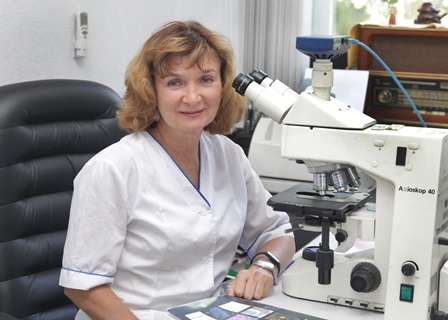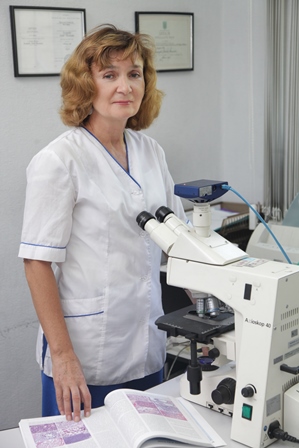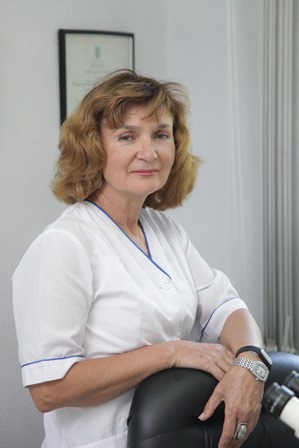(УКР) “ХТО ДОБРЕ ДІАГНОСТУЄ – ТОЙ ДОБРЕ ЛІКУЄ”. ІНТЕРВ’Ю ІЗ ЗАВІДУВАЧЕМ КАФЕДРИ ПАТОЛОГІЧНОЇ АНАТОМІЇ №1 ЛЮБОВ’Ю ЗАХАРЦЕВОЮ

”There is nothing important than saving a human life”: the interview with the head at department of pathological anatomy No 1 at O.O. Bohomolets National medical university Liubov Mykhaylivna Zakhartseva.
Liubov Mykhaylivna Zakhartseva – doctor of the highest category under specialty “pathological anatomy”, Doctor of Medicine, head at division of immunohistochemical researches in Association of anatomical pathologists of Ukraine, member in consulting expert groups at MHC of Ukraine “Standards of diagnostics and treatment of myeloproliferative disorders” (2014-2016), “Standards of diagnostics and treatment of orchioncus” (2016), “Standards of diagnostics and treatment of myeloproliferative disorders at children” (2012-2015), member in editorial board of journal “Oncology”, author of scientific researches, textbooks and articles and since 2016 – head at department.
The largest pride of O.O. Bohomolets National medical university during 175 years of history always was and will be the students. In process of time the students become graduates – the best specialists. Since July, 2016 namely the graduate of Kyiv medical university at that time (and now O.O. Bohomolets NMU) headed one of the oldest departments of university – pathological anatomy No 1.
How did your professional career start?
I am Kyivan; I studied at Kyiv medical university. After graduation from university I received the job placement to Turkmenistan state medical institute. I started my labor activity at the post of teacher of infectious diseases and epidemiology. In 1986 when the tragedy happened in Chernobyl NPP, I returned to Kyiv. Already then our state needed the doctors-specialists, who would study the diseases that became hereditary after terrible catastrophe. I became the junior scientific researcher in laboratory of histological diagnostics at Kyiv scientific research radiology and nuclear medicine and oncology institute and since 1988 – doctor-pathological anatomist.
Please, tell us about your scientific researches, as well as the main research on which you have been working during your medical activity.
Since 1995 I was one of the first in the territory of CIS countries who started working on immunohistochemical researches for diagnostics of human diseases. The implementation of this methodology allowed deeply learning the molecular biological peculiarities for tumors, forecasting their clinical run and sensitivity to treatment. It enabled the doctors developing the individual protocols of treatment and thanks to it improving the survival rate of oncological patients. After implementation of immunohistochemical indices for tumor at breast cancer patients the 10 years survival rate of such patients has increased by 15%. Thanks to development and implementation of immunohistochemical methodology for study of blood cells, the conditions for application of international classification of lymphoproliterative diseases were established. But my activity was not limited only by classical histological, immunohistochemical researches of tumors; I tried to study the genetic mutations of tumors. Thus, during 5 years I could work with the group of geneticists under supervision of corresponding member in NAMS of Ukraine, professor Nataliia Gorovenko, who established the scientific school of complex researches on the role of genetic and environmental factors in appearance of hereditary and multifactorial pathology of human. This scientific group for the first time in Ukraine performed the large-scale researches on hereditary breast cancer, defined the frequency in mutations of genes BRCA1/2. The genetic research of approximately 800 breast cancer patients of different age was performed in Kyiv. This allowed me determining the peculiarities for molecular biology of breast cancer at women of young age and tendency to growth in indices of sickness rate with this cancer at women of up to 35 years. Now I am taking part in international scientific research on peculiarities for breast cancer at liquidators and injured persons after breakdown at ChNPP.
You passed through probation abroad…
Yes, at PhenoPath laboratory under supervision of professor Allenа Gоwnа – scientist – anatomical pathologist, leading world expert in diagnostic and research applications of immunohistochemistry. Since 1998 until 2000 I had the probation in the United States of America, namely in Seattle (state Washington). Later I took part in the conferences of European organization “Europa Donna” and events, held by public organization of breast cancer patients. I myself performed the conferences with international participation, trainings, master classes for pathological anatomists of Ukraine, I established and I am the head at community of pathological anatomists in immunohistochemical researches. For many times I took part in European Congresses of pathological anatomists (2003, 2005, 2006, 2009, 2014), European conferences in breast cancer (2004, 2006, 2010) and international courses of Armed Forces Institute of Pathology (AFIP, 2005).
Liubov Zakhartseva – representative of one of the noblest occupations.
Why have you chosen the occupation of doctor?
Perhaps, I had the influence from the words that I read in book by Anton Chekhov when I was a teenager: “the occupation of doctor is the act of bravery; it requires the dedication, purity of soul and purity of thoughts. Not everyone can do it”. I thought, would I be able? Would I be able to be as persistent and self-sacrificing as those doctors, who studied the infectious diseases, from time to time making the experiments on themselves? They are Doctor A. White, O.O. Mochutkovskyy, G.N. Mynkh, I.I. Mechnikov, N.F. Gamaleya, A.A. Bogdanov, et al. Thus I went to Turkmenistan, where at that time there was the high sickness rate of infectious diseases. I saw the epidemics of hepatitis there, about which they told “Neither A, nor B”. Now we know that it is C but in 1986 they still studied that disease. I saw many people, who suffered from those infections, about which we now only read in books. By the way, I have 10 publications from that time about infectious diseases. After Chernobyl breakdown I thought that it was necessary to study the oncological diseases. The essence of tumors in malfunction of cells and a pathological anatomist is engaged in study of morphological manifestations of those malfunctions. It was interesting for me to work in this direction.
In 1992 I defended the Candidate’s dissertation (“Morphological diagnostics of histiocytic sarcoma”) and started working in Kyiv city clinical oncological center, where I was at the head of pathoanatomical department. At oncological center I created the collective of professionals in pathoanatomical service. All laboratory assistants have the higher education; they passed through probation at famous specialists in the USA. The pathoanatomical department has the modern equipment and became advanced thanks to modern methods of research and constant control of foreign colleagues. Every day I accept tens of patients of different age from all Ukraine for specification of pathoanatomical diagnosis. I am glad when I can cancel the oncological diagnosis of patients, especially children, after reasonable substantiation. And if I confirm the diagnosis, I try to determine the efficient methods of treatment taking into consideration the molecular biological peculiarities of tumor. It provides with the hope. There is nothing most important than saving a human life. I think that I have become a doctor for the sake of this. I have already been working for more than 20 years and often and often I make sure that the best symbol for our occupation is “a burning candle’ – a beautiful and precise symbol for one of the most humane occupations.
It so happened that I often worked at some posts. Combining the practical and scientific work, I worked at my native O.O. Bohomolets National medical university as an assistant at department of pathological anatomy (since 1993 until 1995), department of oncology (since 2004 until 2015) and at the Institute of genetic and regenerative medicine of NAMS of Ukraine as a leading scientific researcher in laboratory of RNA diagnostics in department of genetic diagnostics (2007-2012). The post of head at department as a profession of doctor requires the constant work over me and every minute vigilance because we pass all our knowledge, abilities and experience to our students and the future of Ukrainian medicine will depend already on them. The colleagues – employees of department help me very much, I did not manage to do a half of things without them.
What role does the students’ scientific club at department play? Do the students involve into scientific practical life of department?
The participation of students in scientific club of department is the original form to improve the quality and efficiency of study. Our students self-improve and further the results from their scientific research work may be used in medical research. The fact for involvement of a student into scientific researches itself testifies to certain personal qualities, being available at him/her, inclinations and capabilities, our task at department is to develop such capabilities. As the working experience in SSC at department of pathological anatomy No 1 testifies, while fulfilling the independent scientific researches the students have the higher interest in modern clinical diagnostic methods and responsibility for work, the scientific thinking is actualized, the knowledge is deepened and, mostly important, the professional features for a future doctor are formed. This year the members in club at our department took the prize place at Republican Olympiad in c. Kharkiv. I think that it is my duty to establish the conditions for fulfillment of students’ scientific researches. This is our future.
 What is the main thing in attitude of doctor to patient and head at department to students?
What is the main thing in attitude of doctor to patient and head at department to students?
Humanism and honesty. Each human deserves of the truth and good students, of being open and ready to help. The mutual trust and respect shall be between a patient and a doctor and a student and a head at department. I openly discuss the diagnosis and perspectives of treatment with patients.
What kind of vocational guidance and perspectives of department do you see in the future?
For a long time the pathoanatomical service has been in decay in the country. There has been the catastrophic situation with human resources. During recent 20 years the staffing level of doctors – pathological anatomists was less than 40%. The prestige of profession decreased. Now this profession experiences the new rise thanks to appearance of new possibilities, provided by histochemistry, immunohistochemistry, molecular diagnostics. The leading pathoanatomical department includes a molecular biologist, geneticist. The role of pathological anatomist in life-time diagnostics has significantly grown. The biopsic material is taken by needle from all organs, even the brains. All that increases the requirements to occupational training of specialist. My task is to show the importance of pathological anatomist in life-time diagnostics to the students, to show the directions for possible scientific work.
What is professional credo?
“The precise diagnosis”. I always remember: “qui bene diagnostic – bene curat” (who diagnoses well – that treats well).
Press center



